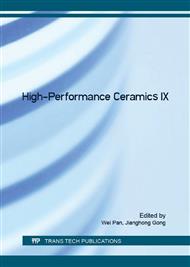p.706
p.710
p.714
p.718
p.723
p.727
p.733
p.737
p.741
Composition, Structure and Electrical Resistivity of ZnO1-x Films Deposited by RF Magnetron Sputtering under Various O2/Ar Gas Ratios
Abstract:
ZnO1-x thin films were deposited by RF magnetron sputtering on conducting silicon wafers at room temperature with ZnOn (n≤1) target under an atmosphere of O2/Ar ratio varying from 0 to 2.0. The correlation between composition, structure and electrical resistivity of the obtained films was investigated. X-ray diffraction analysis revealed that the prepared würtzite ZnO1-x films had c-axis preferential growth orientation. When the O2/Ar ratio was lower than 0.5, the main form of defects in the films was oxygen vacancy; when it was 0.5, the composition of the film approached to the stoichiometric ZnO and had the least number of defects; after that, the main type of defects in the films was interstitial zinc. Thus, with increasing O2/Ar ratio, the electrical resistivity of the films increased first and then decreased.
Info:
Periodical:
Pages:
723-726
Citation:
Online since:
July 2016
Authors:
Keywords:
Price:
Сopyright:
© 2016 Trans Tech Publications Ltd. All Rights Reserved
Share:
Citation:


